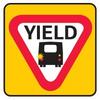 The other day I was following a bus. He put on his four way flashers and pulled completely off the road into a bus stop, so I proceeded to pass. When I was beside the bus, he pulled out and I had to swerve to avoid a collision. They do have a yield sign on the back of the bus, but don't they have to re-enter traffic yielding just like anyone else on the road?
The other day I was following a bus. He put on his four way flashers and pulled completely off the road into a bus stop, so I proceeded to pass. When I was beside the bus, he pulled out and I had to swerve to avoid a collision. They do have a yield sign on the back of the bus, but don't they have to re-enter traffic yielding just like anyone else on the road?
Yielding to a Bus
On any road in British Columbia where the speed limit is 60 km/h or slower, you must yield to a bus that is displaying the prescribed yield sign and is signalling that it wants to move out of the curb lane or bus stop.
Starting From a Stopped Position
That said, the driver of the bus must not move onto the travelled portion of the roadway unless that movement can be made in safety. There are two rules in the Motor Vehicle Act requiring this, one specifically for a bus such as this one and one for all traffic in general. The bus must be granted right of way and the driver was wrong to force it.
Pass With Care
It is also possible that the driver failed to identify you as a hazard, either because he did not look or looked but did not see. In your case this was a single laned roadway and you had no option but to pass by carefully. Had it have been a multiple laned roadway, you might consider that something like this could occur and move to the left lane before passing the bus.
Learn More
- Yielding to Bus - Section 169.1 MVA
- Transit Bus Yield Signs - Division 19.15 MVAR
- Starting Vehicle - Section 169 MVA
- Sharing the Road - Learn to Drive Smart, Chapter 6 Page 93
Share This Article
... that if that bus driver only had four way flashers showing (hard to tell once you're adjacent to it of course), then he had not met the requirements under 169.1 (1) (b).
And it's not entirely apparent from the original poster's text whether or not that bus actually became stationary, before pulling out again. Because the most fundamental right-of-way rule for everybody in every instance is that once a vehicle stops moving, it's incumbent on the driver to ensure that Section 169 Starting Vehicle is obeyed, regardless of what they're driving.
- Log in to post comments
- Log in to post comments

It's worth noting ...